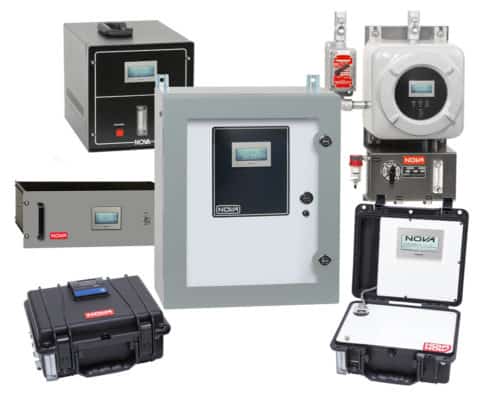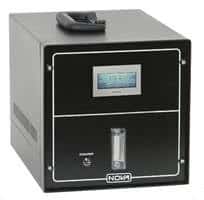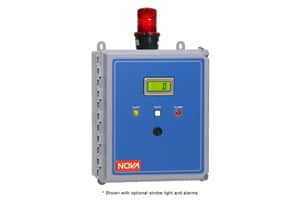Carbon Dioxide (CO2) Analyzers
Carbon Dioxide Gas Analyzer Models
Nova has the capability for carbon dioxide measurement using infrared methodology. Our CO2 analyzer can be supplied with a built-in sample pump or a pressure regulator to suit most applications. Portable and permanent continuous models are available. Many of the analyzers shown here also measure other gases besides CO2.
Nova Analytical offers the following carbon dioxide analyzers:
CO2 Gas Analysis
 Carbon dioxide is a gas of interest in many analytical applications. Infrared detectors, also known as NDIR analyzers, can be used to measure CO2 because it is an excellent absorber of infrared energy. Carbon dioxide can be measured in percent (%) and parts per million (ppm) depending on the requirements of the application.
Carbon dioxide is a gas of interest in many analytical applications. Infrared detectors, also known as NDIR analyzers, can be used to measure CO2 because it is an excellent absorber of infrared energy. Carbon dioxide can be measured in percent (%) and parts per million (ppm) depending on the requirements of the application.
The off-gas stream that results from steel-making applications, such as EAFs, contains carbon in the form of CO2. Some metal heat treat applications utilize CO2 as a part of the carbon-containing atmosphere. The CO2 levels can be dynamically measured in these cases and is usually present at percent levels. Measuring CO2 in these applications may be important for energy balance, end-point determination, and maintaining product hardness and quality.
Carbon dioxide is also a by-product of combustion. In combustion applications, such as boilers, furnaces, and heaters, carbon dioxide measurement can be used with temperature and oxygen content to evaluate efficiency and burner performance. To tune a boiler for maximum efficiency and fuel savings, a portable CO2 analyzer with measurement in the in the percent range is helpful.
Carbon dioxide is also a by-product of three of the four basic bio-chemical stages of landfill gas production. Measuring CO2 and methane (CH4) in landfill gas is useful for determining the gas quality. If the produced gas is burned in an engine, the exhaust products will also contain CO2. Measuring the CO2 in the engine exhaust using a flue gas analyzer may also be useful in evaluating engine efficiency.
In the agricultural and food storage industries, CO2 plays a critical role in the growth of plants and the storage of produce. A controlled atmosphere of low oxygen and elevated CO2 is used to disinfect produce, prolong freshness, and control insect pests. Maintaining adequate CO2 levels in greenhouses will ensure proper plant growth and productivity.
The toxicity of CO2 is one reason why a reliable air quality monitor may be required in a facility. Furnaces, boilers, combustion engines, controlled atmospheres, and other processes may give off dangerous amounts of CO2. The Permissible Exposure Limit (PEL, by Time-Weighted Average as stated by OSHA) of CO2 gas is currently 5,000 ppm over 8 hrs. Therefore, an air quality monitor that can provide analysis at the ppm level is important.

Carbon dioxide is used in some fire suppression systems to extinguish fires in engine rooms, ship holds, electrical areas, dust collectors, and other areas with specific hazards. Fire testing and investigation applications may require the simultaneous analysis of CO2 at various strata in a space during a controlled fire event. A modified portable CO2 analyzer with three separate CO2 channels is available from Nova for this purpose. See this Nova blog post.
In gasification applications, CO2 is often used as an agent during the reduction phase. Carbon dioxide and water vapour are passed over a bed of hot char and are converted to CO and H2 which can be burned later as fuel gases. Measuring the CO2 in the produced gas or ‘syngas’ can help evaluate gasifier operation.
Ready for the next step? Please contact our Sales team for more information.
Or to provide us with more information about your application, please complete our Application Questionnaire and our Sales team will follow up with you promptly.
Applications of CO2 Analyzers
Industries use CO2 analyzers to detect carbon dioxide within a given sample or the amount present in an environment. For certain applications, carbon dioxide may pose serious health hazards to workers when using equipment, processes, or materials. In other instances, such as carbonated drinks in the beverage industry, a manufacturer may desire a specific amount of carbon dioxide in their products. Equipment and processes that may use CO2 analyzers in their applications:
- Landfill gas production and agricultural. These industries monitor the level of carbon dioxide produced during the course of operations.
- Combustion engines, furnaces, and boilers. Many types of machinery and equipment produce carbon dioxide as a byproduct when burning fuel. CO2 analyzers detect the amount of the gas produced to determine if the machines are functioning properly and in accordance with regulatory standards. These can include 5-Gas Analyzers which measure CO, CO2, HC, O2, and NOx.
- Fire suppression, pharmaceutical, food and beverage, laboratories, research, and industrial. Businesses operating in these industries may need carbon dioxide in various amounts to manufacture products, conduct research, suppress fires, and more. CO2 analyzers ensure the right amount of carbon dioxide is present for the intended purpose.
- Gasification. These applications deliberately convert biomass materials into product and by-product gases such as carbon dioxide, carbon monoxide, hydrogen, and others. CO2 analyzers help to monitor the amount of CO2 produced.
How Does a CO2 Analyzer Work?
A CO2 analyzer evaluates the proportional differences between a sample and a reference to detect the presence of carbon dioxide. The instrument relies on non-dispersive infrared (NDIR) sensors that emit infrared radiation at specified wavelengths. These wavelengths pass through the sample tube being analyzed and a reference tube that contains a non-absorbing gas.
The wavelengths are measured based on the absorption rate of the gases. The wavelength for the non-absorbing gas will remain unaltered in the reference tube. If carbon dioxide is present in the sample tube, the infrared wavelength changes as the carbon dioxide absorbs it. The CO2 analyzer will detect the carbon dioxide gas concentration and provide a measurement in parts-per-million (ppm) or as a percentage.
How Do You Choose a CO2 Analyzer?
Selecting an optimal CO2 analyzer for your needs will depend upon the details of your use case, such as the operating environment and the speed requirements of the analysis. Evaluate the specifics of the application and how CO2 is used, emitted, or generated in the process. It will also be important to evaluate the conditions of the sample gas. Then you may decide whether you require an analyzer to continuously measure samples, or whether a portable instrument for making intermittent spot-check measurements only when required will suffice.
Also consider the environment where the analysis will take place. Will the CO2 analyzer be used in a hazardous location? Also determine if samples can be brought to the analyzer or if the analyzer must travel to the testing location to weigh your need for stationary or portable equipment.
Lastly, think about the range of detection that the CO2 analyzer should have. You may only need to detect carbon dioxide, but some applications may require the ability to detect other gases such as carbon monoxide or oxygen.
What Is CO2?
Carbon dioxide (CO2) is an important gas with numerous connections to biological, atmospheric, oceanic, environmental, experimental, and industrial processes.
It exists in the earth’s atmosphere at an approximate concentration of 0.0390% by volume or 390ppm. In May 2013, atmospheric concentration reached 0.04% or 400ppm for the first time in possibly millions of years. Carbon dioxide is a greenhouse gas because it inhibits outward thermal radiation from the earth – in other words, it traps heat.
Sources of CO2 are numerous. Natural sources include volcanoes, organic matter combustion, respiration of living things, fermentation, and photosynthesis. Anthropogenic, or unnatural, sources primarily include fossil fuel burning, power generation, transportation, heating buildings & homes, and industrial processes such as iron & steel, cement, and chemical production. Deforestation also contributes to CO2 accumulation by removing a critical natural CO2 sink.









